Meet the LEGO Women of NASA
Posted on Categories Discover Magazine
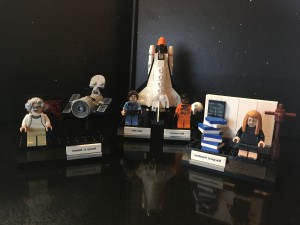
It’s not too often that a toy depicts a real-life unsung hero in science, but the LEGO Women of NASA kit does that four times over. A couple of the names should be familiar — Sally Ride is the go to name for women in space and Margaret Hamilton’s picture has been making the rounds for a while now. Mae Jamison and Nancy Grace Roman, on the other hand, are probably less recognizable. But all four are incredible women whose mini-likeness you can now add to your own home decor.
It was created by Maia Weinstock, a former science journalist now working in MIT’s publicity office. Though her own background is in biological sciences, she was always interested in space, and, of course, the female pioneers in the field. That’s where the inspiration for the kit came from: she wanted something that would bring attention to lesser known women in space while still having mass market appeal. The LEGO Ideas competition presented the perfect opportunity. Weinstock pitched a set of five female space scientists and hoped public interest would get it made. The idea resonated with people, hitting the necessary 10,000 votes to pass onto the next stage in just over two weeks. As the kit developed so did the women, shrinking from a set of five to four. I built the kit myself so can attest that it’s both fun and totally adorable, definitely a great way to learn about — or teach your kids about! — four incredible figures.
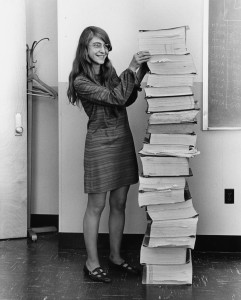 Margaret Hamilton
Margaret Hamilton
The name Margaret Hamilton (the scientist, not the actress who played the wicked witch of the west in The Wizard of Oz) should ring a bell if only because of this picture on the left. Always interested in math, Hamilton worked developing computer software with MIT in an era where computer science and software engineering were barely recognized as disciplines. Regardless, MIT was a great place to be after President Kennedy promised America a Man on the Moon by the end of the 1960s. The first contract NASA let as part of the Apollo program was to the MIT Instrumentation Lab (now the Draper Lab) to build the guidance computer and the software program that would get the spacecraft from the Earth to the Moon. This was in 1961, and as one of the few people in the world with experience in the nascent field, Hamilton ultimately became the leader of the team who wrote that guidance software.
The most famous story about that software is probably the 1202 Alarm. As Neil Armstrong and Buzz Aldrin were descending toward the Sea of Tranquility, their Lunar Module computer gave them a 1202 program alarm; the crew also got a similar 1201 alarm during the incident but we don’t talk about that one as much. These program alarms were caused by a procedural error that had left the LM’s rendezvous radar sending false data to the computer. The 1201 and 1202 codes indicated a data overflow, but the program was smart enough to ignore the data and continue with the primary duty of managing the lunar landing. If it hadn’t the crew would have have to abort.
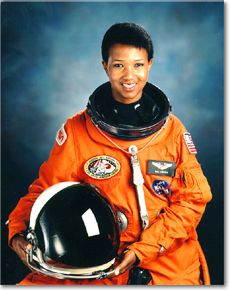 Mae Jemison
Mae Jemison
Mae Jemison has a pretty interesting background. As an undergraduate she earned a bachelor of science in chemical engineering while also fulfilling the requirements for a bachelor of arts in African and Afro-American Studies — scientists do well to be well-rounded in their education! She followed that up with a doctorate degree in medicine, and then set her sights on NASA. Jemison joined the astronaut corps in 1987, one of 15 selected from 2,000 applicants.
After five years of training, she launched as a science mission specialist on STS-47 mission on September 12, 1992, becoming the first black woman to fly in space. Part of the mission was the Spacelab-J experiment, a cooperative undertaking between the United States and Japan. The experiment called for round-the-clock microgravity investigation into: biotechnology, electronic materials, fluid dynamics and transport phenomena, glasses, ceramics, metals and alloys, acceleration measurements, human health, cell separation and biology, developmental biology, animal and human physiology and behavior, space radiation, and biological rhythms. So a lot that would benefit from a doctor on board!
Jemison landed after 190 hours, 30 minutes, 23 seconds in space. She left NASA the following year.
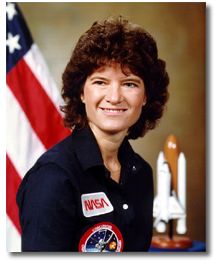 Sally Ride
Sally Ride
Of all the women in this set, Sally Ride is probably the most obvious choice. She was, after all, the first American woman to fly in space. Ride was another well-rounded astronaut holding a bachelor of science in Physics, a bachelor of arts in English, and a master of science and doctorate in Physics. She joined NASA in January 0f 1978 as part of Group 8, the first astronaut class in almost a decade. It was a landmark class that finally changed the basic requirements. NASA was no longer only taking former military test pilots and scientists in alternating classes. Now the agency was taking classes comprised of pilot-astronauts and mission specialists, opening the door for more diverse applicants. It was also the first class to take women — Ride was one of six women selected — as well as people of colour.
Ride served as CAPCOM on the STS-2 and STS-3 missions before being assigned as a mission specialist on STS-7. When the mission launched on June 18, 1983, she became the first American woman in space spending 147 hours in orbit on that flight. Ride flew again on STS 41-G, which launched on October 5, 1984, and added 197 hours to her space-time tally. Ride was assigned to the crew of STS 61-M, but training was cancelled in the wake of the Challenger disaster in January of 1986. Instead of training for space she served as a member of the Presidential Commission that investigated the accident.
After leaving NASA in 1987, Ride worked as a physics professor, authored science books, and cofounded the Sally Ride Foundation to inspire students in STEM fields. She died in 2012 and was posthumously awarded the Presidential Medal of Freedom.
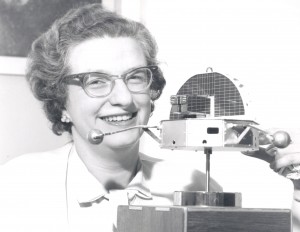 Nancy Grace Roman
Nancy Grace Roman
Probably the least recognized name on this list, Nancy Grace Roman also has longest space career. Born in 1925, she wasn’t much older than the original astronauts nor the men who walked on the Moon, so she came scientifically in the golden age of space exploration. This also means she was pursuing a career as a scientist at a time when women were told they couldn’t work in “male” fields. That didn’t deter Roman.
When she was 11, Roman got some friends together to form an amateur astronomy club where they would learn about constellations. From there her path was set. Overcoming the hurdles of guidance counsellors deterring her from pursuing math and physics, she earned a bachelor of arts in astronomy and followed that with a PhD. It was during her time as a post-doc and professor that Roman made a discovery that put her on the map among her male peers. In looking at bright stars similar to the Sun, she noticed that those with heavier elements orbit closer to the Milky Way’s galactic centre in a more circular path whereas those with lighter elements follow elliptical paths. It was an early clue to our galaxy’s evolution. Following this newfound interest on galactic structures, Roman studied the elemental composition of stars, and during this work noticed something odd. One star that should have been akin to our Sun had a very different spectra. Her brief note about the star — AG Draconis — caught the attention of Gerard Kuiper, namesake of the Kuiper Belt, who offered her a position at the US Naval Research Laboratory.
Roman left the NRL not long after NASA opened its doors on October 1, 1958. As the Chief of Astronomy and Relativity Programs in the NASA Office of Space Science, she was responsible for developing and organizing scientific participation in programs while maintaining standards of integrity and meeting budgetary constraints. She left NASA and management behind in 1974 but stayed with space. Seeking a job in the private sector led her to contractors working on the Hubble Space Telescope and ultimate to the NASA Goddard Space Flight Center in the Astronomical Data Center. Adding computer knowledge to her background of astronomy, she helped get Hubble off the ground and ultimately became the centre director in 1995.
The LEGO Women of NASA kit is currently available on Amazon if you’re keen to grab it for someone — or yourself! — for the holidays. And to be clear: LEGO did donate the kit for the video but this isn’t a paid endorsement. I just love it! And if you’re keen to get updates about the product from Maia Weinstock follow her on Twitter or the LEGO Women of NASA account.
Sources are linked within the short writeup of each woman. Additional sources: How Apollo Flew to the Moon by David Woods.